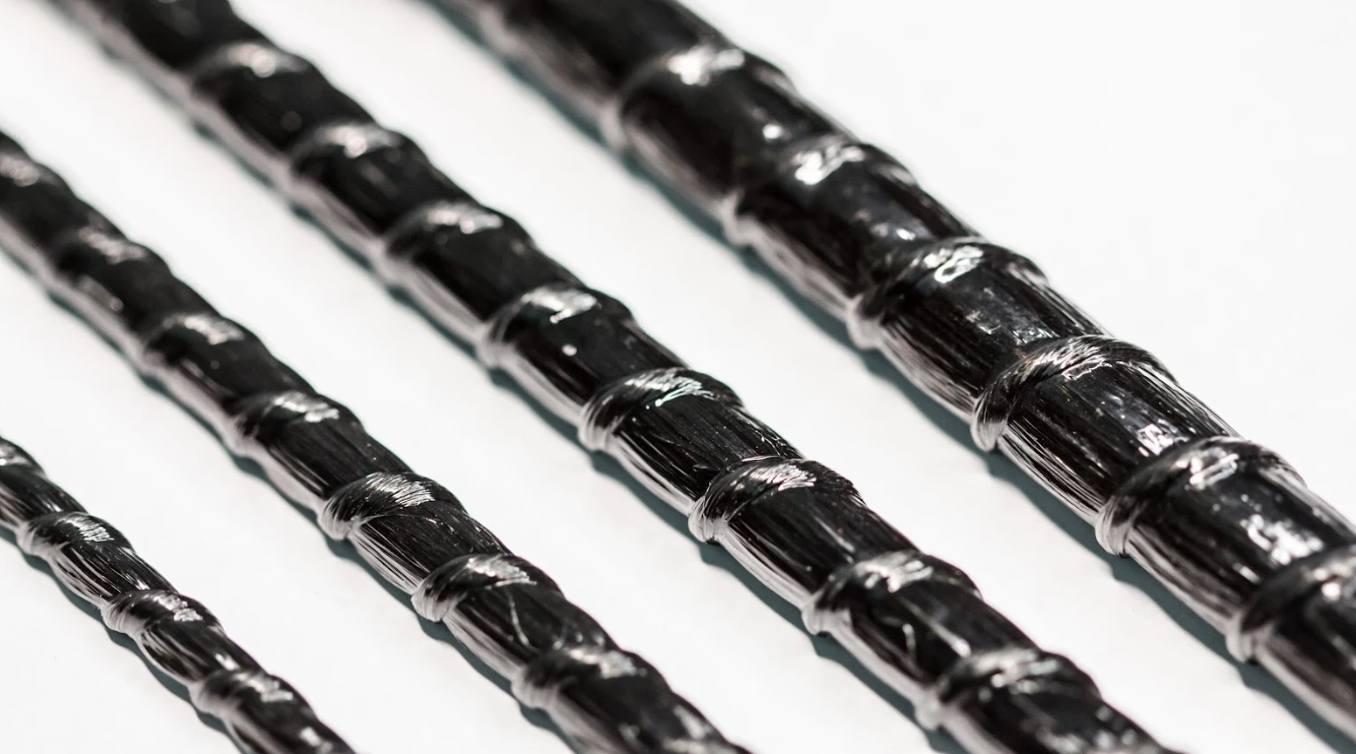Basalt Rebar
Beyond Materials Group offers a wide range of non corrosive basalt materials used in concrete reinforcement, construction and manufacturing. Our non–ferrous reinforcement, Basalt reinforcement rebars and Geogrid mesh have been widely used in production of lightweight concrete panels and marine construction.
Basalt Rebar is an alternative to steel and fiberglass for concrete reinforcement.
Basalt fiber is a high performance non-metallic fiber made from basalt rock melted at high temperature.
Key Benefits of Basalt rebar:
- High strength and low weight
- High corrosion resistance
- High tensile modulus
- Non-conductive and non magnetic
- Easy installation
- Non–ferrous reinforcement,


Basalt rebar has much higher tensile strength than steel or fiberglass rebar of the same diameter.
Being 8-10 times lighter than steel, Basalt rebar is much easier to install.
Corrosion Resistance
Basalt does not rust or absorb water, so the depth of concrete cover can be reduced, allowing for thinner sections and more flexibility of design.
Basalt rebar is perfect for pervious concrete or applications where concrete is exposed to marine environments or areas affected by road salt. Basalt is naturally resistant to alkalis and will not act as a conduit for moisture.
 Tensile Modulus
Tensile Modulus
Since Basalt is so strong in tension and compression, it cannot be bent or formed like steel. If tensile modulus issues arise, modifying the Basalt rebar adding more basalt in finer diameters in tighter grids closer to the surface will overcome any tensile modulus issues. Basalt rebar has the same thermal coefficient of expansion as concrete.
Basalt rebar is easily cut to length with regular tools.
Basalt rebar does not conduct electricity or induce fields when exposed to RF energy, great for MRI or data buildings.
Basalt rebar is perfect for Marine environments and Chemical plants where corrosion is a continuous concern.
Basalt Rebar is available in the following diameters: 4mm. 6mm. 8mm. 10mm. 12mm or customized.
• Stronger than steel wire of comparable size
• By far lighter and easier to handle and install (no nasty cuts).
• Will not rust or corrode or cause cracking of concrete
• Flexible for easier design
• Basalt does not conduct electricity or induce electric fields
• Basalt Mesh binds well with both asphalt and concrete
• Customize mesh sizes available 4-40mm


Basalt Fiber Geo-Grid Mesh
 Used for reinforcing asphalt-concrete (covering in construction, reconstruction and repair of airport, runways, highways and any pavements, pedestrian ways, road inclines and banks).
Used for reinforcing asphalt-concrete (covering in construction, reconstruction and repair of airport, runways, highways and any pavements, pedestrian ways, road inclines and banks).
The reinforcement with basalt mesh Geo-grid increases the overall reliability, safety and the cutting process output. The strength of basalt mesh is as good as metal reinforcement, however it is lighter, thereby simplifying transportation and handling in construction.
Basalt Geo-grid Mesh is more durable than metallic and glass-fiber reinforcement due to basalt fiber’s excellent performance. Like all the basalt articles it is an ecologically safe material.
 Basalt Chopped Fibres can be mixed directly into polymers and concrete to increase tensile strength and reduce cracking and chipping. ( Chopped Carbon Fibres are also available)
Basalt Chopped Fibres can be mixed directly into polymers and concrete to increase tensile strength and reduce cracking and chipping. ( Chopped Carbon Fibres are also available)
Basalt Chopped Fibres – Features & Benefits
 • High tensile strength
• High tensile strength
• Resistant to alkali in concrete and require no special coatings
• Resist cold down to -260°F and heat up to 1,500°F
• Do not conduct electricity or induce electrical fields
• Do not absorb or wick water
• Will not harbor bacteria or microbial growth
• Has good fatigue resistance
Beyond Materials Group is a growing manufacturer of non–ferrous basalt fibre materials and can meet your specification and quality requirements for a wide variety of custom applications. From our head office in Gold Coast we are able to ship our basalt products Australia wide. BFRP
Gold Coast, Brisbane, Sydney, Adelaide, Melbourne, Perth.
 Tensile Modulus
Tensile Modulus
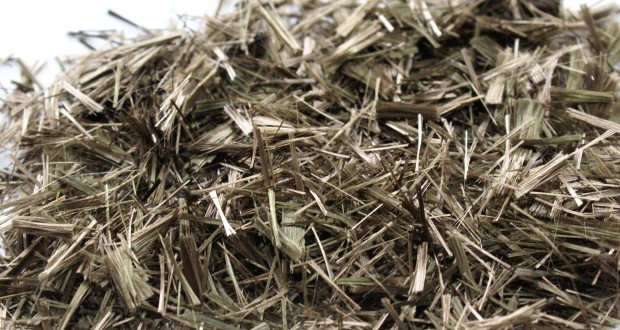


 The findings have shown that BFRP rebar is a stronger and lighter alternative to steel reinforcement in concrete beams, and that it is a very promising building material for the future. Furthermore, fewer material and energy resources are required during the production process, which leads to a better environmental profile with fewer embodied emissions. In contrast, the mechanical testing part of this experiment showed that the BFRP reinforcement has a lower elastic module than steel reinforcement. This disadvantage leads to excessive deformation at service limit state compared to steel bars, if the same cross-section area is used. However, compared to steel, BFRP does not exhibit yielding during tension. When the BFRP environmental results were compared to EPD data, there were two core findings. Firstly, EPDs for precast steel reinforced concrete beams have a similar amount of GWP emissions, ranging from 25.1 – 27.9 kgCO2eq/FU, compared to the steel reinforced concrete beams tested in this study, 23.7 kgCO2eq/FU. Secondly, when the EPD data for precast beams was replaced with EPD data for in-situ pouring concrete and 100% recycled steel, embodied emissions were significantly reduced to 11.3 kgCO2eq/FU. This result is competitive with the BFRP reinforced concrete beam that experiences 14.6 kgCO2eq/FU. These results highlight the environmental benefits to be
The findings have shown that BFRP rebar is a stronger and lighter alternative to steel reinforcement in concrete beams, and that it is a very promising building material for the future. Furthermore, fewer material and energy resources are required during the production process, which leads to a better environmental profile with fewer embodied emissions. In contrast, the mechanical testing part of this experiment showed that the BFRP reinforcement has a lower elastic module than steel reinforcement. This disadvantage leads to excessive deformation at service limit state compared to steel bars, if the same cross-section area is used. However, compared to steel, BFRP does not exhibit yielding during tension. When the BFRP environmental results were compared to EPD data, there were two core findings. Firstly, EPDs for precast steel reinforced concrete beams have a similar amount of GWP emissions, ranging from 25.1 – 27.9 kgCO2eq/FU, compared to the steel reinforced concrete beams tested in this study, 23.7 kgCO2eq/FU. Secondly, when the EPD data for precast beams was replaced with EPD data for in-situ pouring concrete and 100% recycled steel, embodied emissions were significantly reduced to 11.3 kgCO2eq/FU. This result is competitive with the BFRP reinforced concrete beam that experiences 14.6 kgCO2eq/FU. These results highlight the environmental benefits to be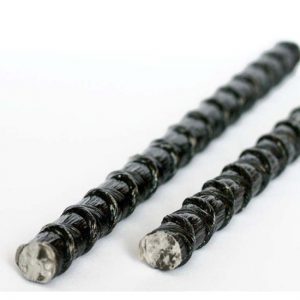 Another core finding was that both the BFRP tendons and reinforcement steel have similar emission factors: 2.6 and 2.34 kgCO2eq/kg respectively. However, since BFRP has a lower specific weight to steel, and is three times lighter, the overall embodied emissions are much lower in the BFRP reinforced concrete beams. This is because less material (per kg) is required to perform the same function. When considered without concrete, the LCA results showed the largest contributor to BFRP emissions was resin (86.8%). It was therefore ascertained that the LCA results are sensitive to the type and quantity of resin used, and that the amount of embodied emissions arising from resin are a significant driver of high emissions in BFRP tendons. This finding highlights an area for optimisation in the future. BFRP manufacturers could therefore experiment with the
Another core finding was that both the BFRP tendons and reinforcement steel have similar emission factors: 2.6 and 2.34 kgCO2eq/kg respectively. However, since BFRP has a lower specific weight to steel, and is three times lighter, the overall embodied emissions are much lower in the BFRP reinforced concrete beams. This is because less material (per kg) is required to perform the same function. When considered without concrete, the LCA results showed the largest contributor to BFRP emissions was resin (86.8%). It was therefore ascertained that the LCA results are sensitive to the type and quantity of resin used, and that the amount of embodied emissions arising from resin are a significant driver of high emissions in BFRP tendons. This finding highlights an area for optimisation in the future. BFRP manufacturers could therefore experiment with the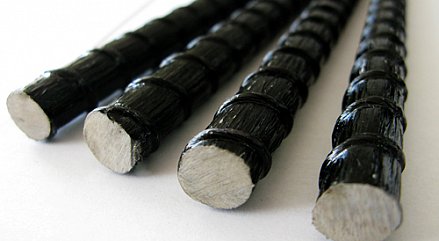
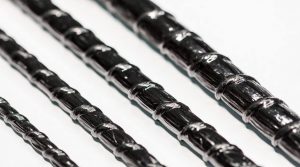 Another type of non ferrous fibre that has gained popularity in the last two decades is basalt fibre. Various manufacturers have employed this fibre because of its low cost, high ecological compatibility during the production process, and functional properties . The density of basalt (2600 kg/m3) is approximately one third of the density of steel (7680kg/m3), which means Basalt FRP is a lighter, stronger construction material compared to steel. It is expected that these mechanical properties will have implications on the environmental performance of BFRP as a construction material. Furthermore, it is easier and cheaper to produce basalt fibres, compared to other fibre types such as glass fibre. A previous study estimates the energy required for basalt fibre production to be around 5 kWh/kg in an electric furnace, whilst the energy required to produce steel is around 14 kWh/kg [13]. It is expected that this disparity in energy consumption will have an impact on the environmental performance of Basalt FRP. BFRP reinforcement bars are therefore a promising material in concrete as a replacement for steel reinforcement bars.
Another type of non ferrous fibre that has gained popularity in the last two decades is basalt fibre. Various manufacturers have employed this fibre because of its low cost, high ecological compatibility during the production process, and functional properties . The density of basalt (2600 kg/m3) is approximately one third of the density of steel (7680kg/m3), which means Basalt FRP is a lighter, stronger construction material compared to steel. It is expected that these mechanical properties will have implications on the environmental performance of BFRP as a construction material. Furthermore, it is easier and cheaper to produce basalt fibres, compared to other fibre types such as glass fibre. A previous study estimates the energy required for basalt fibre production to be around 5 kWh/kg in an electric furnace, whilst the energy required to produce steel is around 14 kWh/kg [13]. It is expected that this disparity in energy consumption will have an impact on the environmental performance of Basalt FRP. BFRP reinforcement bars are therefore a promising material in concrete as a replacement for steel reinforcement bars.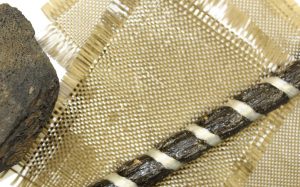 In order to convert the fibres into Basalt FRP tendons, the CBF is glued together with resin. In some cases, sand is gluedto the BFRP rebar surface to give a higher level of cohesion between the Basalt FRP rebar and concrete. The total proportion of resin varies from 20 to 40% of the total product volume, and differs from manufacturer to manufacturer. However, epoxy resin is typically used. The Basalt FRP rebar is then pre-stressed to up to 50% of its ultimate strength, prior to inclusion in the concrete beam. Basalt FRP tendons have a tensile strength in order of 1000 – 1300 MPa. In comparison,steel reinforcement has a tensile strength of around 500 MPa. The elastic module of basalt fibre is much lower than steel, of around 70 GPa . One of the main advantages of using Basalt FRP as a strengthening material in concrete is that it is non-corrosive . This property is advantageous in structures under severe attack from salty or damp environments, for example, the top layer of reinforcement in bridge decks, in concrete floors in multi-storey car parks, groundwork and foundations, or structures located by the coast. In conventional houses, Basalt FRP bars offer the possibility of reducing the amount of concrete required, and may allow for thinner concrete members because of the strength and corrosion-resistant properties of basalt, which requires less passivating layers of concrete to limit the transport of oxidants towards the reinforcement bars. This may also in turn lead to a reduction in material consumption. Reduced material consumption will lead to a reduction in embodied energy and material emissions. On the other hand, the elastic module for non ferrous Basalt FRP tendons is much lower than that for steel. This disadvantage leads to excessive deformation at service limit state compared to steel bars, if the same cross-section area is used. However, compared to steel, basalt fibre does not exhibit yielding during tension. The BFRP material is purely elastic. A relaxation test of the Basalt FRP reinforcement bars has been ongoing at SEL since 2013. Reykjavik University estimate an expected final relaxation value of 6% after 50 years.
In order to convert the fibres into Basalt FRP tendons, the CBF is glued together with resin. In some cases, sand is gluedto the BFRP rebar surface to give a higher level of cohesion between the Basalt FRP rebar and concrete. The total proportion of resin varies from 20 to 40% of the total product volume, and differs from manufacturer to manufacturer. However, epoxy resin is typically used. The Basalt FRP rebar is then pre-stressed to up to 50% of its ultimate strength, prior to inclusion in the concrete beam. Basalt FRP tendons have a tensile strength in order of 1000 – 1300 MPa. In comparison,steel reinforcement has a tensile strength of around 500 MPa. The elastic module of basalt fibre is much lower than steel, of around 70 GPa . One of the main advantages of using Basalt FRP as a strengthening material in concrete is that it is non-corrosive . This property is advantageous in structures under severe attack from salty or damp environments, for example, the top layer of reinforcement in bridge decks, in concrete floors in multi-storey car parks, groundwork and foundations, or structures located by the coast. In conventional houses, Basalt FRP bars offer the possibility of reducing the amount of concrete required, and may allow for thinner concrete members because of the strength and corrosion-resistant properties of basalt, which requires less passivating layers of concrete to limit the transport of oxidants towards the reinforcement bars. This may also in turn lead to a reduction in material consumption. Reduced material consumption will lead to a reduction in embodied energy and material emissions. On the other hand, the elastic module for non ferrous Basalt FRP tendons is much lower than that for steel. This disadvantage leads to excessive deformation at service limit state compared to steel bars, if the same cross-section area is used. However, compared to steel, basalt fibre does not exhibit yielding during tension. The BFRP material is purely elastic. A relaxation test of the Basalt FRP reinforcement bars has been ongoing at SEL since 2013. Reykjavik University estimate an expected final relaxation value of 6% after 50 years.




 Used for reinforcing asphalt-concrete (covering in construction, reconstruction and repair of airport, runways, highways and any pavements, pedestrian ways, road inclines and banks).
Used for reinforcing asphalt-concrete (covering in construction, reconstruction and repair of airport, runways, highways and any pavements, pedestrian ways, road inclines and banks).
 • High tensile strength
• High tensile strength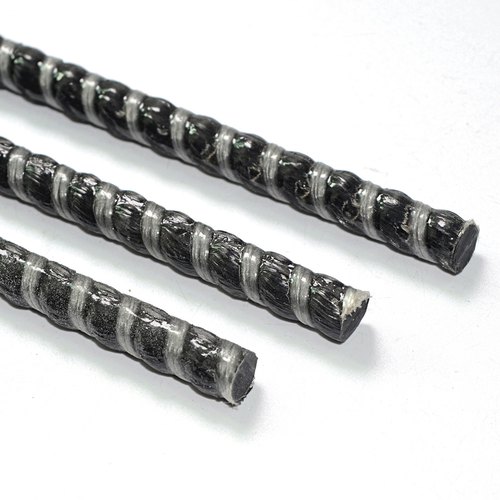
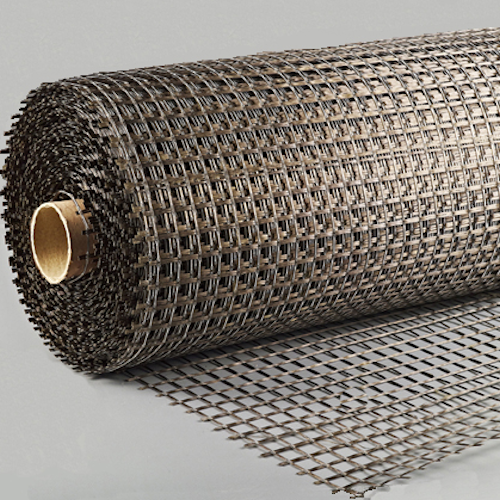
 Basalt reinforcing mesh with alkali resistant coating was developed to prevent cracks as well as for reinforcement of mortars and non load bearing concrete.
Basalt reinforcing mesh with alkali resistant coating was developed to prevent cracks as well as for reinforcement of mortars and non load bearing concrete.